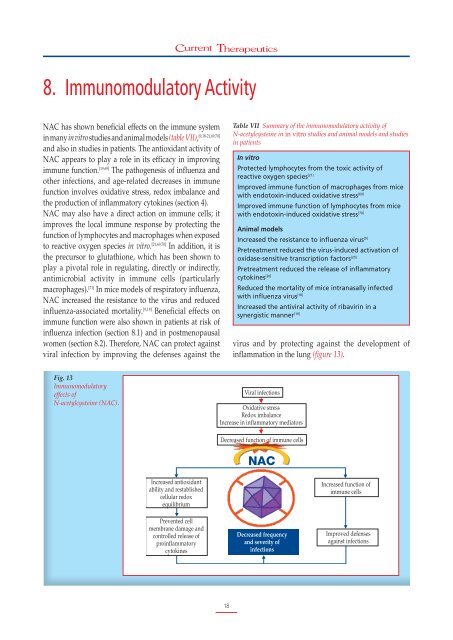Therapeutics
Role of N-Acetylcysteine
Role of N-Acetylcysteine
- No tags were found...
You also want an ePaper? Increase the reach of your titles
YUMPU automatically turns print PDFs into web optimized ePapers that Google loves.
Current <strong>Therapeutics</strong><br />
8. Immunomodulatory Activity<br />
NAC has shown beneficial effects on the immune system<br />
in many in vitro studies and animal models (table VII), [9,18-21,69,70]<br />
and also in studies in patients. The antioxidant activity of<br />
NAC appears to play a role in its efficacy in improving<br />
immune function. [19,69] The pathogenesis of influenza and<br />
other infections, and age-related decreases in immune<br />
function involves oxidative stress, redox imbalance and<br />
the production of inflammatory cytokines (section 4).<br />
NAC may also have a direct action on immune cells; it<br />
improves the local immune response by protecting the<br />
function of lymphocytes and macrophages when exposed<br />
to reactive oxygen species in vitro. [21,69,70] In addition, it is<br />
the precursor to glutathione, which has been shown to<br />
play a pivotal role in regulating, directly or indirectly,<br />
antimicrobial activity in immune cells (particularly<br />
macrophages). [71] In mice models of respiratory influenza,<br />
NAC increased the resistance to the virus and reduced<br />
influenza-associated mortality. [9,18] Beneficial effects on<br />
immune function were also shown in patients at risk of<br />
influenza infection (section 8.1) and in postmenopausal<br />
women (section 8.2). Therefore, NAC can protect against<br />
viral infection by improving the defenses against the<br />
Table VII Summary of the immunomodulatory activity of<br />
N-acetylcysteine in in vitro studies and animal models and studies<br />
in patients<br />
In vitro<br />
Protected lymphocytes from the toxic activity of<br />
reactive oxygen species [21]<br />
Improved immune function of macrophages from mice<br />
with endotoxin-induced oxidative stress [69]<br />
Improved immune function of lymphocytes from mice<br />
with endotoxin-induced oxidative stress [70]<br />
Animal models<br />
Increased the resistance to influenza virus [9]<br />
Pretreatment reduced the virus-induced activation of<br />
oxidase-sensitive transcription factors [20]<br />
Pretreatment reduced the release of inflammatory<br />
cytokines [20]<br />
Reduced the mortality of mice intranasally infected<br />
with influenza virus [18]<br />
Increased the antiviral activity of ribavirin in a<br />
synergistic manner [19]<br />
virus and by protecting against the development of<br />
inflammation in the lung (figure 13).<br />
Fig. 13<br />
Immunomodulatory<br />
effects of<br />
N-acetylcysteine (NAC).<br />
Viral infections<br />
Oxidative stress<br />
Redox imbalance<br />
Increase in inflammatory mediators<br />
Decreased function of immune cells<br />
NAC<br />
Increased antioxidant<br />
ability and restablished<br />
cellular redox<br />
equilibrium<br />
Prevented cell<br />
membrane damage and<br />
controlled release of<br />
proinflammatory<br />
cytokines<br />
Decreased frequency<br />
and severity of<br />
infections<br />
Increased function of<br />
immune cells<br />
Improved defenses<br />
against infections<br />
18


